Projects of self-propelled anti-aircraft installations based on the tank Pz.Kpfw.V Panther (Germany)
At the end of 1942 and the beginning of 1943, the German industry began working on various options for building anti-aircraft self-propelled guns on the chassis of existing tanks. During the 1943-44, several developments based on the Pz.Kpfw.IV tanker reached limited series production and operation in the military. In parallel, projects of similar technology were created on the basis of the tank Pz.Kpfw.V, however, they never left the design stage and were not implemented in the metal. It should also be noted that such a fate befell at once several ZSU projects based on the “Panthers”, which were being developed at different times.
According to reports, the first version of anti-aircraft self-propelled guns based on the Pz.Kpfw.V tank was proposed back in late 1942. It was proposed to remove the turret from the base armored vehicle and to install the 18 mm FlaK 88 anti-aircraft gun in its place. It was assumed that such an armored vehicle would be able to move along with various units and provide them with protection against attacks aviation the enemy. Nevertheless, this project did not leave the stage of preliminary studies and remained on paper.
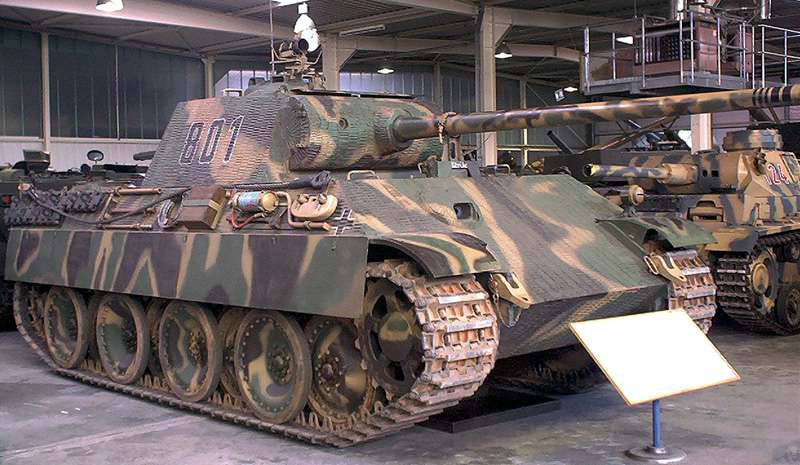
Tank Pz.Kpfw.V - a failed basis for promising ZSU. Photo of Wikimedia Commons
Theoretical studies have shown that self-propelled chassis with large-caliber guns are of particular interest to the troops, but more important for the army are ZSU with automatic small-caliber guns. For this reason, at the beginning of 1943, the development of new versions of self-propelled guns based on the Panther, which were proposed to equip several-caliber small-caliber guns, started. We considered the armament of the machine in the form of four 20-mm cannons, two or three 37-millimeter or paired installation with 55 mm caliber guns.
Base chassis
To simplify the development and construction of new equipment, it was proposed to use the existing tank chassis with minimal design changes. Moreover, in the end, it was possible to do without any modifications of the hull and other chassis units: all that had to be changed was the internal equipment of the combat compartment, which should correspond to the new purpose of the vehicle. All other components and assemblies remained in place.
One of the main features of the base chassis was a powerful reservation made from sheets of thickness up to 80 mm. In theory, this allowed the ZSU to work at the forefront with minimal risk of being hit by enemy shells. The power plant and the undercarriage of the existing chassis made it possible to work in the same combat formations with other tanks of various types, which made it possible to protect the equipment from raids on the march, in positions and during combat.
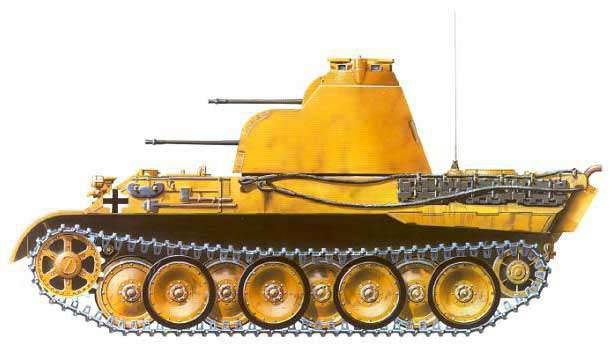
Estimated appearance of the first version of the ZSU with four 20-mm guns. Figure Aviarmor.net
The project of the medium tank Pz.Kpfw.V implemented the main ideas characteristic of the German tank construction of the time. For example, used the traditional layout of the body with the front of the transmission and the separation of management, located next to it. The central compartment was given under the fighting compartment, and in the stern was located the engine with the necessary units. Another characteristic feature of the "Panther" and other German tanks of the time was the so-called. Knipkamp suspension. As part of the chassis there were eight dual road wheels on each side, arranged in a checkerboard pattern.
Tanks Pz.Kpfw.V first editions were equipped with gasoline engines Maybach HL 210 P30. Later, the HL 230 P45 engine, which developed power up to 700 hp, replaced this product. Through the main clutch, drive shaft, seven-speed gearbox and other units, the engine torque was output to the front drive wheels. To simplify the production, the gearbox and the main steering mechanism were made in the form of a single unit.
2 cm Flakpanzer V
As part of the new ZSU projects, it was proposed to replace the original tank tower with new combat modules with the appropriate weapons. The first was proposed option with 20-mm guns. By the summer of 1943, the company Rheinmetall-Borsig had completed the preliminary development of a similar system, which was supposed to provide high firepower and efficiency in the fight against air targets.
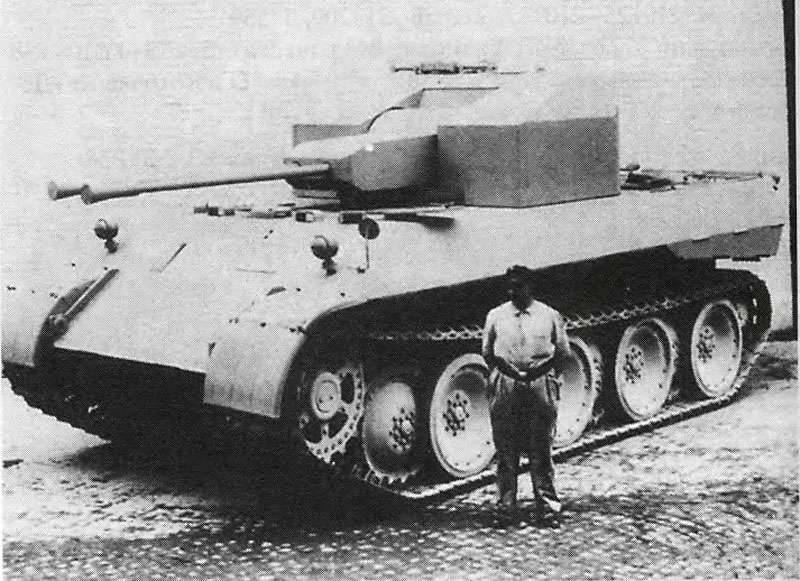
The only full-size model built under the Flakpanzer V project is the Coelian ZSU. Photo Chamberlain P., Doyle H. Complete reference book of German tanks and self-propelled guns of World War II
Exact information regarding the appearance of such a tower has not been preserved, which leads to the appearance of various versions. According to one of the assumptions, the tower for four guns should have a box-shaped front part and a conical stern, and also be made in the form of a two-tier unit. In this case, two guns were to be placed in its lower part, and the other two - at the top. Nevertheless, it cannot be excluded that a quadruple system similar to those used in anti-aircraft units could be mounted in the tower. The drawings of this tower, unfortunately, are not preserved.
The main weapons The ZSU Flakpanzer V of this version should have become four automatic MG 151 / 20 air cannons. Such a gun with automatics, working on recoil trunks, could make up to 750 rounds per minute (3 thousand shots in total) and attack targets at ranges up to 1,5 km. In ammunition guns included shells of several types. Due to the high rate of fire and the use of four guns in one installation, it was possible to significantly increase the probability of hitting and to some extent compensate for the small power of the projectiles.
In the autumn of the same year, the potential customer reviewed the proposed project and ordered that further work be refused. The short range of fire, combined with the lack of power of ammunition did not allow to carry out effective air defense. Even the four MG 151 / 20 guns did not allow the troops to be protected from the attack of modern or advanced aircraft.
Flakpanzer 341 Coelian
A project with four 20-mm guns was abandoned in the fall of 1943, and a new order arrived at the beginning of winter. Now the industry had to create a new ZSU with automatic guns caliber 37 and 55 mm. Such a weapon should have given a significant increase in firepower, range and effectiveness.
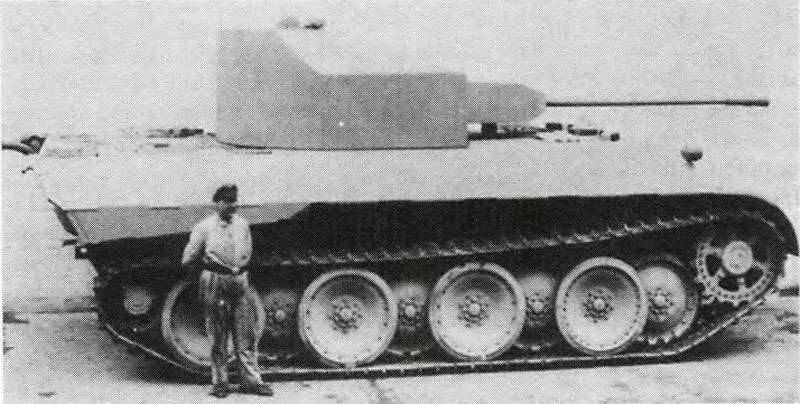
Layout on a real chassis from a different angle. Photo Chamberlain P., Doyle H. Complete reference book of German tanks and self-propelled guns of World War II
The result of the new works was the appearance of the second version of the tower with anti-aircraft weapons. Krupp and Daimler-Benz companies (according to other data, Rheinmetall) created a rotating turret with fastening systems for two 37 mm caliber guns. This project reached the layout of a promising machine and therefore became the most famous representative of the Flakpanzer V family. In various sources, a self-propelled gun with a pair of 37-mm guns is designated as Flakpanzer 341, Gerät 554 or Coelian.
A new type of tower was proposed to be assembled from a set of armor plates of different thickness and shape. It is known that in the later stages of development, the design of armor units was considerably simplified, which should have affected the labor intensity of their production. In the final form, the forehead of the tower was formed by vertical lower sheets and inclined upper ones. Vertical sides and curved feeds were also envisaged. The front part of the tower was supposed to have a U-shaped form in terms of and be equipped with a swinging unit for the installation of two guns. The breech of the guns was covered by a common oblong casing.
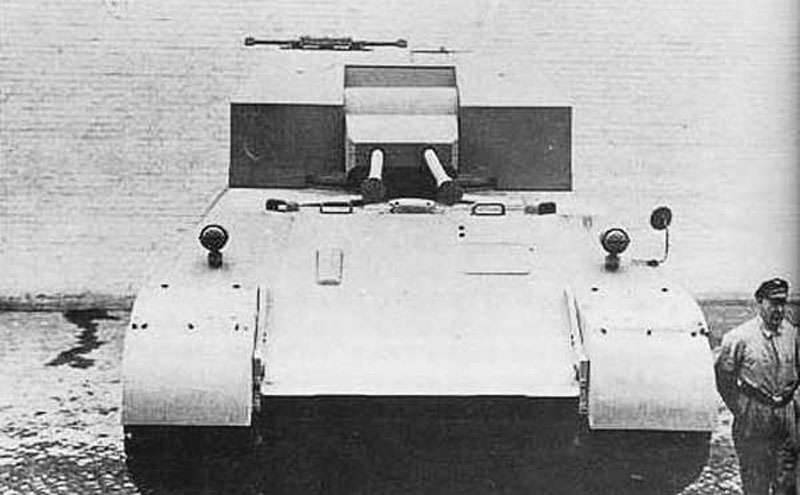
Pitchfork front. Photo Aviarmor.net
As the main weapon for the Flakpanzer 341, two automatic guns 3.7 cm FlaK 43 were offered. Guns with a practical rate of fire up to 150 shots per minute could accelerate a projectile to speeds over 1000-1100 m / s and fire at ranges up to 2 km (at air targets) or up to 6-6,5 km (on land). Guns with automatic on the basis of exhaust gases for ammunition used clips on 8 shells each.
The design of the Coelian machine continued until the fall of 1944. By this time, the new construction of the tower was worked out and some other changes were made. The work resulted in the assembly of a prototype model of a promising anti-aircraft self-propelled gun. For its construction was taken available in the presence of the chassis of the tank Pz.Kpfw.V Ausf.D, recently undergone repairs. A tank was removed from the tank, and in its place was installed a wooden model of a promising unit with automatic guns. Such a product could not be used for military purposes, but demonstrated the general provisions of the project. In particular, the tower could rotate and change the angle of elevation of the guns.
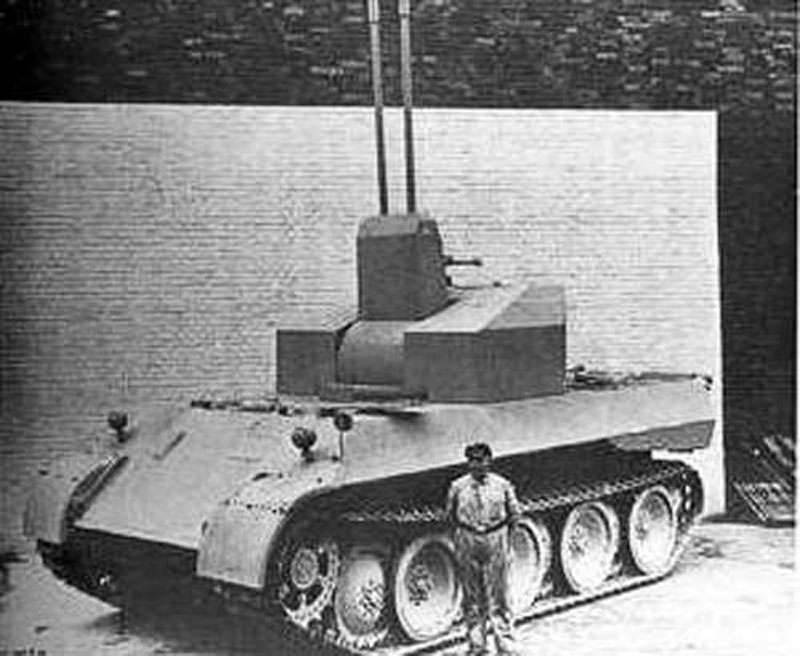
Flakpanzer 341 with a maximum angle of elevation of the guns. Photo Aviarmor.net
Layout ZSU Flakpanzer 341 showed the military and those with some reservations approved the project. It was recommended once again to rework the tower, taking into account developments on the new modifications of the tank "Panther", as well as make some other changes. After that, the car could be launched into a series and sent to the troops.
5.5 cm Flakpanzer V
In early November, 1944, the company Rheinmetall presented the documentation and the layout of another ZSU, which was proposed to arm with two guns of 55 caliber mm. This project was developed in parallel with the Flakpanzer 341 machine and almost simultaneously with it reached the construction stage of a demonstration layout. In some sources, an anti-aircraft self-propelled project with paired 55-mm guns is referred to as Gerät 58. At the same time, it is known that such a name was borne by promising 55-mm guns, proposed for use on the new ZSU. Probably in this case there is a simple confusion.
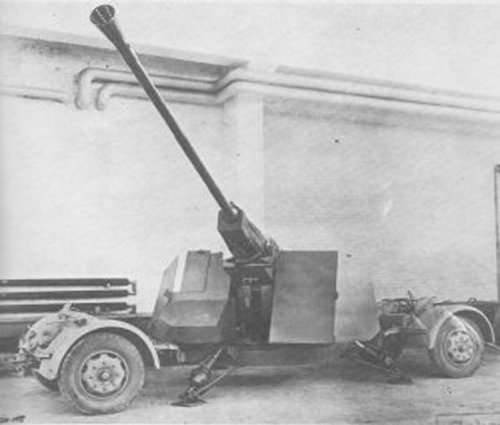
One of the two built prototypes of the Gerät 55 58-mm cannon mounted on a towed carriage. Photo Wehrmacht-history.com
In the project of the company "Rheinmetall" it was proposed to use a larger tower, the dimensions of which were related to the size of the weapons used. The tower of complex polygonal shape was proposed to be assembled from straight-line armor plates littered inside. In the frontal part of the tower was provided a large cut-out for the free movement of guns in the armor cover. In terms of the overall layout of the gun mount, the Rheinmetall project was no different from that developed by Krupp and Daimler-Benz.
As a weapon for the new version of the Flakpanzer V, two Gerät 58 automatic cannons, developed in the 1944 year, were proposed. The gun had a barrel length 4,22 m (76 calibers) and had to work using the energy of powder gases. Automation allows you to shoot single or bursts at a rate of up to 150 rounds per minute. For use with the new cannon, 55x450 mm B projectiles were developed, which were proposed to be supplied with five rounds of ammunition each. The power of the gun made it possible to fire at air targets at distances up to 4 km and altitudes up to 2,5 km.
Two such guns were to be mounted on a common installation in a tower of appropriate size and used when attacking aerial targets. In addition, the power of the guns allowed the infantry to fire support and destroy the enemy’s equipment or fortifications.
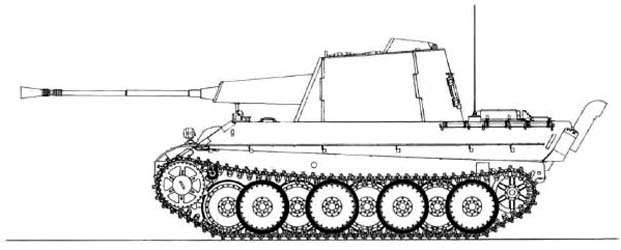
Side view of the ZSU with 55-mm guns. Figure Aviarmor.net
In November, 1944, the developers of the 5.5 Flakpanzer V project presented a model of this machine, made on the scale of 1: 10. The project interested customers, but they demanded some changes. So, it was decided to equip the turret with a commander turret borrowed from the Pz.Kpfw.V tank, and also to supplement the existing armament. For some reinforcement of the main weapon and expansion of the range of tasks, two Gerät 58 guns were proposed to be supplemented with MG 151 / 20 guns and MG 42 machine guns in various combinations. In this embodiment, anti-aircraft self-propelled gun could count on entering the mass production.
Project results
By the end of 1944, two projects of promising ZSU on the basis of the tank Pz.Kpfw.V Panther had managed to advance quite far, right up to the stage of the last project changes and preparation for the construction of prototypes. However, only a few months remained until the end of the war, and German industry had already suffered serious losses. As a result, none of the projects of anti-aircraft self-propelled guns based on the Panther tank reached the assembly and testing of prototypes. In the case of the two most successful projects, everything ended in the manufacture of layouts.
Due to the difficult situation at the front, the general problems of the industry and the alleged long-term fine-tuning of projects, the army decided to abandon the continuation of work on Flakpanzer V. 14 February 1945, all work on what seemed to be a promising direction was completely stopped. The Flakpanzer 341 and 5.5 cm Flakpanzer V projects have almost been redesigned to meet new requirements, but they have been ordered to close. All efforts needed to focus on the release of equipment already in mass production.
It should be noted that the implementation of new projects was difficult and without the decision of the military. So, for the construction of self-propelled guns with twin guns caliber 55 mm required to start mass production of such weapons. However, until the end of the war, Germany managed to collect only two prototypes of Gerät 58 cannons. Thus, the possible supply of guns for the ZSU was a big question. The second version of the self-propelled gun, Coelian, could also face serious difficulties of a production nature.
Despite all the efforts, the German specialists did not succeed in successfully implementing the projects of self-propelled anti-aircraft installations based on the Panther tank Pz.Kpfw.V. It was proposed several options for such technology, but they all appeared too late and required the creation of a significant number of new nodes and assemblies. In addition, the final requirements for the new technology were identified literally a couple of years before the end of the war. As a result, a number of projects that were of some interest and had great prospects were not brought to mass production or at least to the construction of full-fledged prototypes. The task of self-propelled armaments of troops with anti-aircraft weapons again did not receive a complete solution.
Based on:
http://lexikon-der-wehrmacht.de/
http://achtungpanzer.com/
http://aviarmor.net/
http://armor.kiev.ua/
http://navweaps.com/
http://wehrmacht-history.com/
Chamberlain P., Doyle H. Complete reference book of German tanks and self-propelled guns of the Second World War. - M .: AST: Astrel, 2008.
Information